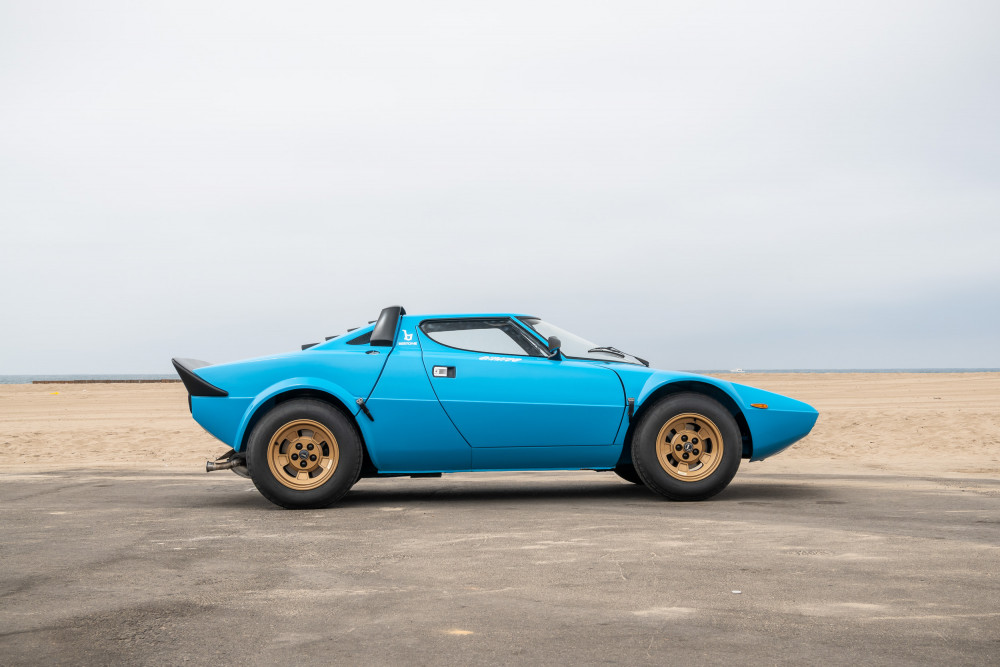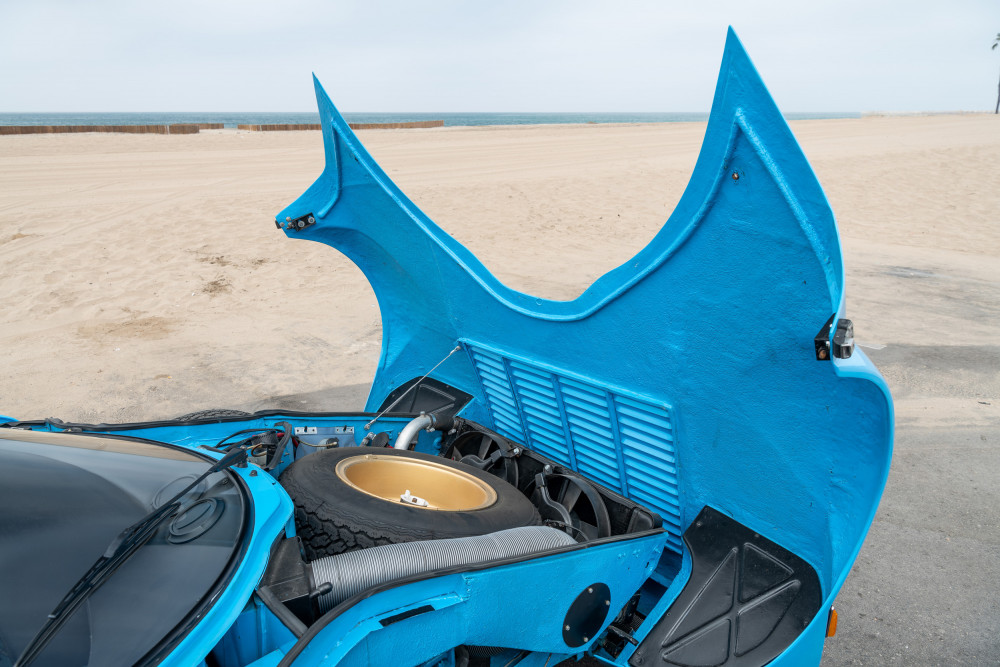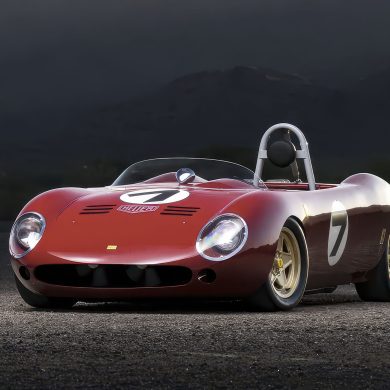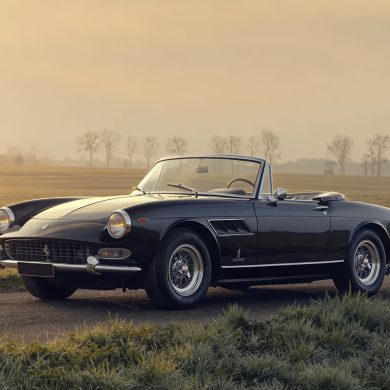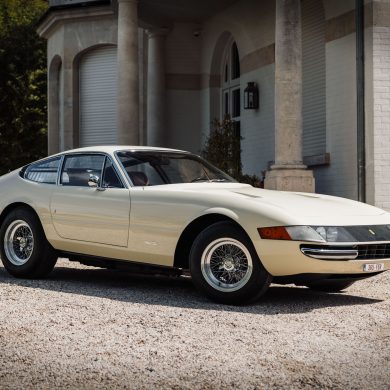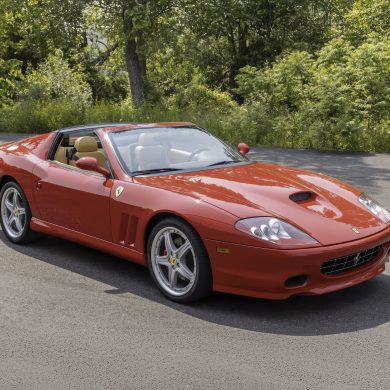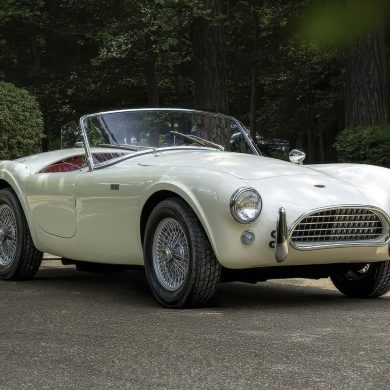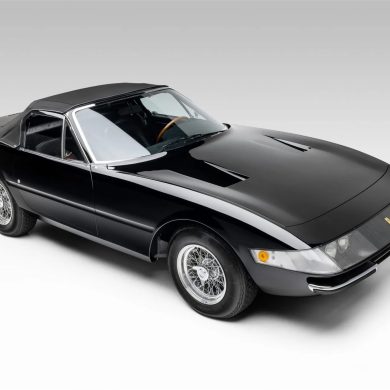For the classic car enthusiast, auctions are a veritable gold mine of possibility. There are auctions for every type of vehicle from a first generation Mazda MX-5 to a classic Jaguar E-Type. With as many types of buyers as there are out there, there are auctions of every type, from the gigantic Barrett-Jackson and Pebble Beach auctions, to the local auction house, to even online auction sites.
It is that last area where Stratas Auctions comes in. Founder Lance Butler, himself a classic rally car enthusiast that has had experience in both restoring classics and performing collection management, found himself looking around at online auction sites in late 2019, where he would have to enter a variety of search terms and advanced search filters to even get to cars that might be in his areas of interest. This, to him, felt very disconnected, very impersonal, and, in a word, clunky. It was more of the rote “click this, buy that” type of mentality that was focused more around churning out auctions as fast as possible, instead of taking the time to find the right car for the right collector community.
As such, in 2020, Lance drafted up his idea on a single piece of paper. Take the idea of community first, personalizing the buying experience second, and then building an auction site around that. To him, the key factor that was missing was the word-of-mouth excitement that buzzed through dedicated communities that were built up around brands and even specific cars, and making the connection from seller to community as easy as possible. Stratas launched in the first quarter of 2020, and almost immediately had an impact.
Now, in October 2021, Stratas has built from being the idea of one man with a passion for classic rally cars to full blown, dedicated classic and collector auction site with the personal touch. The team has grown exponentially, from Lance himself contacting communities and sellers personally, to a full team of classic car experts with their own specialities combing the globe to get the best cars in front of buyers that have a passion for them.
We here at Sports Car Digest had the privilege of sitting down over the phone with Lance at the start of October to discuss the amazing growth of the site, the few challenges that he and the team have had to solve over the past year and a half, and where things are going from here.
Interview with Lance Butler, Founder of Stratas Auctions
Note: Selected portions of the interview have been selected and edited for clarity and conciseness.
Lance Butler, Founder and CEO of Stratas Auctions.
Our interviewer for the day was Simon Bertram, a content writer for Sports Car Digest. Much like Lance, he is very enthusiastic about classic rally cars, and can probably speak for hours on end regarding the Group B and Group N eras of the World Rally Championship.
Simon Bertram (SB):
To get it out of the way in advance, thank you for taking the time from your schedule to sit down with us for this interview.
Lance Butler (LB):
You’re most welcome, always happy to talk about classic cars!
SB:
As with all founders of companies, there is that one key moment, that one driving force that makes them start up their companies. What, for you, was the driving force that made you decide to start up Stratas?
LB:
Originally, I started off in the restoration world, and from that moved on to collection management, where I would work for collectors buying cars, restoring cars, racing cars, and the like. For that, I had to really understand the mindset of what collectors like and dislike about the sales world.
I was managing a collection in Chicago, and ended up moving back to Los Angeles, where I’m from, due to an opportunity to work at one of the in-person auction houses. Having spent time working for who is the end user of these cars, understanding why they collect and what they want out of these cars, the in-person auction experience is significantly different behind the scenes than it appears from the outside.

I felt that the in-person auction “tool,” as it is, underserves the collector that it’s trying to work with, and the community that that collector is part of. That is what Stratas was formed to fix, to focus on what buyers and sellers enjoy, and putting that into one platform. The idea that an item is curated, something that a collector would specifically seek out, instead of what you would find on a higher volume auction site, is what really drives Stratas. In a way, taking the best bits of doing the in-person work, but bringing in online.
To us here at Sports Car Digest, this resonates strongly with each and every member of the team. We too have looked at online auction sites, including from the big houses like Sotheby’s and Gooding & Company, and despite there being good write ups, car histories, and the like, there is still the sense that it is more of a seller driving the auction process than the company actually curating the car for sale.
To have a company actually take the viewpoint of the buyer, of the collector, with a keen eye towards what that collector actually wants is a refreshing take on an already impersonal digital world. We next asked about one of the most frustrating things regarding in-person auctions, the fact that you only get a few moments to inspect the car you’re looking at.
SB:
It definitely is a nicer way to get the cars in front of collectors. When I was browsing the site preparing for this interview, it did occur to me that if you wanted to go to one of the big auctions, like Pebble Beach or Barrett-Jackson, you would sometimes have to fly across oceans to get there, and even then, you aren’t guaranteed to get the car you want. Without securing the car, I think it would feel like a little bit of a wasted trip. How does Stratas work with collectors in that sense?
LB:
When you think about the logistics of buying a car at, for example, Pebble Beach, there’s not only the chaos of finding a hotel or housing at a reasonable price, getting registered with the auction house, all that, there’s also the fact that you may only be interested in one or two cars from a checklist of two hundred or more.
Meaning, your options for inspecting a car are very limited, versus us, where it’s much easier to fly into LAX or O’Hare or wherever we keep cars across the country to be viewed. You can make it a day trip, fly in, inspect the car with one of our specialists and really get into the details about it, then fly home the same day with a much better appreciation of the car than what you would at, say, Scottsdale or Pebble Beach.
As Lance outlined, this is taking one of the most annoying things about auctions and turning it around into something that a collector appreciates. For anything from a Corvette to a Bentley, or a race car from 1965 or a rally car from 1979, most collectors have educated themselves in what to look for, what questions to ask, what an original wheel rim versus a later year rim looks like, and the like.
How impersonal an in-person or online mass auction can feel. You’re not a client, you’re just a number bidding on something others are bidding on as well.
The fact that there is a Stratas representative there as well adds that personal touch, something that is sorely missing from major auction websites and even the in-person events. By bridging that disconnect, Stratas has already proven through some recent successful sales that giving the collector time to really get under the hood of the car and look at every little detail, it makes a huge difference in buying confidence.
At this point in the interview, the discussion did move a little off topic as there was some fond car enthusiast talk regarding what bits a collector would want to inspect the most, as well as auction experiences and the like. One important piece of information came about because of these few minutes of chatting.
While Stratas does have knowledgeable staff that themselves have come up through the collecting world or have extremely in-depth knowledge of certain brands and classics from hands-on experience, they also have a large network of experts that they can call up at any time. This means that for, say, a one off car made from a series of only 15 cars, if there is an expert that knows everything about that one off, Stratas will simply place the call and bring the expert in for the buyer to get the most confidence in buying that specific car.
SB:
One of the biggest things that you have mentioned about Stratas is that you are pushing much more for the curated experience, the start to finish with both buyer(s) and seller, that makes it an enjoyable experience for all involved. What we haven’t touched on, however, is what, to you, makes a car “Stratas Worthy?” What are you looking for in cars that you want to curate, that you actively go out and see if anyone is selling?
LB:
The focus is on the cars that people can actually envision themselves buying, collecting, using, and enjoying.
As an auction site, we are happy selling everything from the rarest brass era cars to modern supercars and hypercars. I just want to curate the selection of cars through us to where the cars we do offer are good or the best examples of what they are.
For example, with race cars, you’re more concerned with provenance, racing history, who drove the car, where that car placed in the standings. In a lot of cases, people still do want originality, but are a lot more open to swapping or restoring parts. When you buy a race car, you’re buying the history of it, not really worrying about how many times the engine’s been rebuilt or if it had seventeen different liveries, because on a race car, that’s expected due to the specialized machines they are.
On a road car, however, we have a lot of collectors who think something over 5,000 miles is high mileage, and so there really is a fine line that has to be balanced between it being a collector car and a used car. This comes up much more in cars from the 80s, 90s, 2000s, while some cars, no matter the mileage or condition, are collector cars just from the rarity.
Bringing it down to a point, we just want to offer cars that get people excited, that get collectors excited to buy and drive. It’s not very strict, but we also want people to come to see us, come to our site regularly, and see us as a source of good inventory.
SB:
Leading directly on from that answer, are there any sales that have been particularly memorable for you? In the sense that Stratas sourced the car, curated it, had multiple bidders and collectors excited about it, and had a great auction experience with?
LB:
I have two that come to mind: The Renault R5 Turbo Series 1, and Lancia Stratos HF Stradale.
1981 Renault R5 Turbo Series 1 sold by Stratas Auctions.
These two cars are dream cars for me, and so the sellers of those cars were complete rally car nerds. The buyers of each of the cars are so incredibly excited to own them and drive them, and put miles on them to show them to the world and have their collector car experience with those cars.
1975 Lancia Stratos HF Stradale sold by Stratas Auctions.
The Lancia Stratos… you don’t have to put too much of an effort to understand that that car influenced the name of our business. I love that car, its history, its look, its driving experience… everything about it. Translating that into what Stratas is, the Lancia Stratos was the first purpose built rally car, and it was undefeated all the way until they changed the regulations. I wanted Stratas Auctions to be the first purpose built digital collector’s auction site that could excel in a similar way.
But yeah, those two cars are the ones that I wish I could have purchased off of the site, but I’m more than happy with where they have gone, and still have a chance to connect with their new owners and see them in action.
The very fun, different, and even “funky” interior of the Renault R5 Turbo Series 1, designed by Bertone.
Funny story, with the sale of that Lancia Stratos, we’ve had nine collectors reach out to us, right now, to see if we can source more Stratos’ for them. (Short burst of laughter) We’re currently unable to supply the demand in the market! So right now, we’re searching for as many Stratos HF and HF Stradales that we can find.
SB:
That sounds like a good problem to have!
LB:
(Laughs) It was a bit of a running joke in the office within the first couple of cars we sold, with two really well kept Volkswagen Beetles that were bought by appreciative collectors, and we had the office tagline of being “Your online source for VW Beetles!” Now, we’ve got the opposite problem of being known for having high quality Lancia Stratos’, so we might have to change our tagline!
While Lance, naturally, focused on his one true love, the Lancia Stratos, the Renault R5 Turbo Series 1 does deserve some love too. For those unaware, during the 1970s, rallying was newly under the jurisdiction of the Federation Internationale de l’Automobile (FIA), which had created the FIA Group 3 and Group 4 rallying categories, overseen by the FIA sporting arm, FISA.
The Ferrari V6 in the back of the Stratos was one of the keys to its domination of Group 4.
The R5 Turbo Series 1 was developed as a direct response to the Lancia Stratos dominating FIA Group 4 from 1974. It borrowed the idea of a short wheelbase, lightweight car with a powerful engine in the middle powering the rear wheels. Unlike the Stratos, however, it did not use a powerful V6, which was supplied by Ferrari for Lancia.
The massively powerful Renault 1.4L Sierra engine that started at 160 HP before Group B started, and ended at 380 HP during Group B rallying.
Instead, Renault took their 1.4L inline-four Sierra engine and stuck a massive turbocharger on it, a Garrett T3 turbine. In the homologation specials built for the road, the power from this engine was, for its 970 kg (2,138 lbs) weight, a massive 160 HP with 164 lb-ft of torque. The styling was done by Bertone, who also styled the Stratos, and the “angry little French box” was born.
It was very competitive in FIA Group 4 rally competition from its introduction in 1980. As regulations changed over the years, the car went from 180 HP at its introduction, through the start of the insanity that was Group B in 1982 with a bump to 210 HP. In 1984, the final racing and road homologation cars were simply called the Renault R5 Maxi Turbo, and were absolute power monsters, throwing 380 HP out of the engine. However, the writing was on the wall with the Audi Sport Quattro S1 AWD and the Lancia Delta S4 AWD taking power beyond the 500 HP mark, and the R5 bowed out before the 1985 season.
SB:
Could you speak a little as to how you were able to source that Stratos? Was it something that someone submitted, or was it an active search with your staff and specialists to find “The One,” the perfect Stratos to tie in with the Stratas name?
LB:
As you can imagine, we wanted to have a Lancia Stratos for the launch of the business, so we were very intentional about seeking out a Stratos. We had found one for the launch of the new version of our site at the end of 2020, but long story short, the seller wanted to get the car to a different point than it was at, and the connection fell through. It also didn’t help that a month after we launched the business itself, the global pandemic occurred and everything, everywhere, shut down for most of the spring.
From any angle, the Lancia Stratos in Azzurro blue is a stunning vehicle.
We were able to find this specific car because we sourced it through a group of rally car collectors that one of our clients was a member of. So, I personally contacted that member, and asked if he ever wanted to sell the car, if we could feature it on our platform. As it turned out, he was actually in the process of cleaning the car and getting it ready to be sold, so that’s how we got that one, which was exciting to have on the site.
It was also cool to have the Stratos Stradale, as we started to promote the fact we had one for sale through the site by taking the car out to the local Cars & Coffee meets in LA, or taking it out to the beach for the photoshoot. People just don’t see those cars on the road, and it’s a pretty special car to be able to see, as it’s not a Ferrari or a Lamborghini, the “average” sports car that people see in LA.
All original interior, in very good condition.
You’re driving a Lancia Stratos. When people approach you, who know what the car is, they would absolutely freak out with the history of the car, what the car was meant to do, what the car means. They were able to finally see, as some put it, “their car” up close, and that excitement is exactly what we were hoping to get with Stratas.
What was particularly special about the Stratos, it is known in collector communities that mileage, engine rebuilds, body repaints, replacing the clamshells, and the like don’t affect the value of the car all that much as it came out of the factory literally ready to race, just with some roadcar bits stuck onto it. However, the one we sold was all original.
The famous front clamshell, made of fiberglass and designed to be replaced in a hurry during a rally.
It had the original front and rear clamshell, something that simply does not happen in Lancia collector circles. All the original electronics and mechanical components. Most of all, it had the original drivetrain. That’s what made it really special. It was the original 2.4L Ferrari V6, with the original 5-speed manual transmission, with the original serial numbers matching the chassis. That’s what made the car sell as well as it did.
If ever a road-going version of a race car had a menacing, powerful posture…
Right now, we’re looking to find other Stratos’ for collectors, and it’s very difficult to have that perfect combination of being a perfect original parts car, because of the way they were used in period. A lot of Stratos’ were raced and ended up wrecked, damaged, having to be repaired with new components, or were converted to rally spec from the road going version so owners could live out their Group 4 dreams.
That was one of the best cars I’ve personally driven, seen, or sold. All Stratos’ are cool (we both laughed here), no matter what you find, but the price difference between a $400k to $450k Stratos and a beyond $600k Stratos are those few components.
SB:
I’m not surprised that many original owners ended up damaging or crashing their cars. It’s an extremely short wheelbase car with a lot of weight right over the middle, and if you don’t know how to drive a car like that properly-
LB:
(Loud laughter) Yeah! That’s actually one of the fun things about the car, is that when we took it up to the canyons for some photos, the whole driving experience is hilarious. If you come around a corner and start to understeer, you just come off the throttle for a moment, let the nose dip, and you have immediate grip. You have all the weight shifted to the rear and middle, and the car just does not want to turn under power.
You have to drive it dynamically, and drive it almost like you’re in a rally. Brake on the straights, trail it into the corner, and apply the power as you’re coming out of the corner, and even then, you can get the tail to wag with the power it’s putting down.
We included this entire section of the interview unabridged because even when transcribing it into words on a screen, the pure sense of excitement and enjoyment emanating through Lance’s voice is unmistakable. This is a man that believes 150% in what he’s doing, and is putting his heart and soul into the business from the enjoyment of it more than any financial motivation.
We too all have our favorite dream cars, from street cars to rally cars to race cars. Simon’s dream rally car is a Group N 2000 class Subaru WRX WRC, like the one famously driven absolutely on the limit by Petter Solberg throughout the mid-2000’s. What is special about the excitement coming from Lance is that he is actually living his dream.
What rally dreams are made of…
With Stratas, it is apparent that it is more than just a business. The dream of being able to connect collectors, from enthusiastic communities, with sellers, through an auction site that curates and selects the best of the best to represent those collector cars is something that just two years ago wasn’t even written down on a piece of paper. In the intervening time, the dream of seeing, even driving, some of the most collectible, pure examples of both road and race cars has also been realized.
By this point in the interview, it had wound down out of the official time limit that Lance had asked for, but his enthusiasm kept Simon and him talking for a few more minutes. There was honest appreciation for the day-to-day car our writer drives, a 2017 Ford Fiesta ST, which Lance was quick to say was one of the best handling front wheel drive cars he’s been behind the wheel of.
It’s that enthusiasm about everything with a motor in it, from the rarest of road cars like the 1993 Jaguar XJ220 listed on the website, to a thoroughbred, limited edition track bike like the 1993 Ducati Supermono that is listed for private sale on Stratas, that is truly what Lance and company are bringing to the online auction landscape. For them, it’s all about the enjoyment of the process, and making sure that everyone involved enjoys it as well.
The exquisite 1993 Ducati Supermono listed on Stratas Auctions right now. If only we had a spare $200,000…
It’s the personal touch that makes the dream work. Most online auction sites are all about “here’s the lot number, here’s your registration number, bid when the lot is up at the block, good luck.” Stratas is turning that on its head, curating a collection of cars that collectors actually want, and then letting them get up close and personal, have access to experts, inspect the car for far longer than any in-person auction would, and then having a fair and open auction.
There is a saying that we think fits as a great statement to end this profile and interview on, to summarize in a few words what truly shows through with the enthusiasm and excitement about cars and bikes not just from Lance himself, but from the entire staff. It summarizes the story of how Stratas Auctions came to be, and the dream that it will carry forward as the digital landscape continues to evolve…
“If the world can’t change your dreams, your dreams will change the world.”
Stratas Auctions is doing just that for collectors, and we wish them all the success they deserve.


